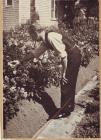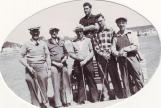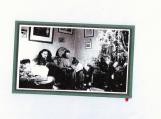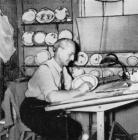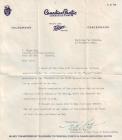28
Whether he was at work or at home, Tom Hulme was a man of routine. He arose each day at 6 a.m. In the winter, he would put on his big fur coat before setting out to face the snow and sub-zero temperatures for his walk to work. Throughout his life, he never owned a car.The evening meal was always at 5 p.m., after which he would read the paper. Then he would retire to what the family called "the little room" where he would sit at his easel and paint. The subject matter varied but often it was a nature scene. Police Point Park, a place where he loved to walk, was a favourite.
On occasion, his youngest daughter Shirley would join him in the little room to do some painting of her own. Her interest in art continues today and her creative endeavours now take the form of painting rocks with images of colourful little houses. In the summer, these whimsical pieces can be found scattered among the flower beds in her back yard.
30
During the warmer months, Tom would exchange his paint brush for a garden spade or a golf club. With a group of friends, he would go out for a round or two at the Connaught Golf Club in the Kensington area, opposite the Husky Station on Highway #1. It seemed that golf, more than anything else, relieved the pressures of work.Summer weekends meant family activities - attending Saturday evening band concerts in Riverside Park, having an ice cream at the soda shop, maybe watching a lawn bowling game in progress.
Summer holidays were usually at the same place every year - Banff - an upstairs suite in a private home that was accessed by a flight of stairs in the back. There were cooking facilities and most meals were eaten in. Even on vacation, dining out was a special thing for the average family. Shirley recalls the time she had her very first shrimp cocktail when one of the Medalta owners took the Hulme family to dinner at The Glass House on First St. N.E. in Medicine Hat.
32
Sunday mornings, the family attended services at St. Barnabas Anglican Church. Tom sang in the choir. During the 1940's, service men who attended the church were often invited to the Hulme house for Sunday dinner. Ruby Hulme kept in touch with those dinner guests for many years after, even keeping in touch with their widows. Tom's own experience of the war, no doubt, played some part in this generosity to soldiers far from their own homes. He was a lifetime member of Robertson Memorial Branch of the Canadian Legion. Remembrance Day, November 11th was always observed and the Hulmes never missed a cenotaph service. Shirley, the sole surviving family member, maintains the custom to this day.
33
Medicine Hat Tigers 193120th Century, Circa 1931
Medicine Hat, Alberta, Canada
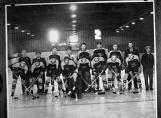 Credits:
Credits:Esplanade Archives, Medicine Hat, Alberta
Mrs. Chris Jeffries
34
On weekends in the winter, the Hulme family would visit with friends; the adults to play cards, the children to simply play. But when the hockey season started, Saturday night was reserved for Hockey Night in Canada. Tom would sit with his ears glued to the radio and the children knew that they were not to make a sound during the broadcast. He supported the local junior team, too. He always had a season's ticket to "the Tigers" games in the old arena on 4th Street, and sometimes billeted players in his home.The family had a lot of portraits taken. In contrast to this, Tom spoke very little of his family in England except when he got a call from his sister Mary with whom he frequently corresponded. His other sister Gert and step-brother Sam had followed Tom to Canada. Shirley cannot recall much mention of her paternal grandparents, even as to their deaths.
At Christmas, Tom set up the Christmas tree and anchored it so securely that even a tornado couldn't have blown it over. The two girls, Lola and Shirley, then had free rein to decorate the tree in any way they wished and there are a few photos in the family albums to prove it. Perhaps it was these early experiences which prepared Shirley for a job she later had at the Eaton's store - decorating their trees for the holiday season.
36
Sometimes, Lola and Shirley got a special treat. When Tom would go to the factory on the weekend to check the results of samples coming out of the kiln, he would take his daughters with him. They loved these excursions. It was an adventure going into the huge buildings, filled with large, mysterious machines and a maze of tracks that ran everywhere. The girls were allowed to look in the peep holes of the tunnel kiln and see the saggar- laden carts inside. Shirley also remembers the stilts stuck to the bottom of the teapots.38
Tom was employed at Medalta for twenty-five years, the entire life of the art department. During that time, his daughters grew up and started work themselves. At sixteen, Shirley went to work at the candy counter in the Eaton's department store and stayed there for many years. With some of her first wages, she bought her parents a television set. In her last three years, she went over to the customer accounts department where Lola also worked. Both girls married, Lola to Frank Coffey, a local car salesman and Shirley to Ernie Albrecht, a young mechanic who later became a firefighter for the city.Tom and Ruby* became proud grandparents when their eldest daughter and her husband had their first child, a boy. Tom was very touched and delighted when they named their son Tom, after him. Needless to say, Tom Junior grew up having a special bond with his grandpa; inheriting his artistic ability as well as his name. Frank and Lola** had three other children, Janice, Charles (Chuck) and Russell, and Shirley and Ernie had one daughter, Kim. Now, there are numerous great grandchildren, too.
39
Newspaper clipping 197220th Century, Circa 1972
Medicine Hat, Alberta, Canada
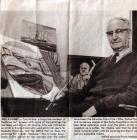 Credits:
Credits:Medicine Hat News, Medicine Hat, Alberta
40
Tom was 62, in 1954, when Medalta Potteries closed its doors. Until his retirement three years later, he went up the road to work at Hycroft China.In 1966, a group of local businessmen in the nearby town of Redcliff decided to start a pottery, using much of the equipment that remained after Sunburst Ceramics, the last pottery on the old Medalta site, shut down. They tried to coax Tom out of retirement to join them. He declined but generously gave one of owners, John Matuska, many of his recipes for glazes.
How amazed Tom would be to know, that so many years later, Medalta Potteries would become a National Historic Site. One can almost imagine him, pipe in hand, with a small smile of wry amusement on his face, at the thought that the every day wares produced by him and the decorating department would some day become coveted collectors' items.
*Ruby Hulme passed away April 15,1998 at the age of 93. **Lola died of breast cancer on August 14, 1988 at the age of 53.
